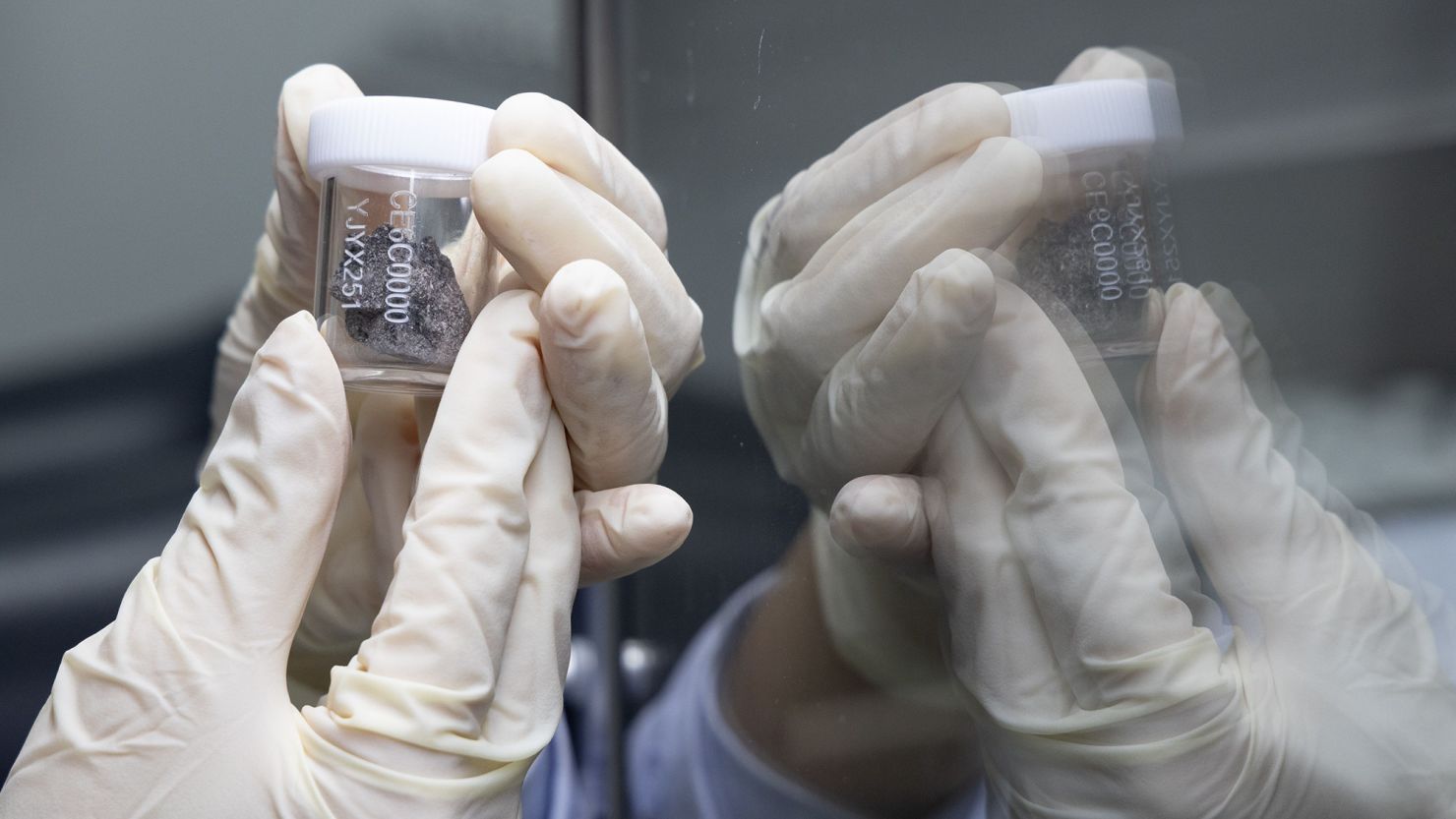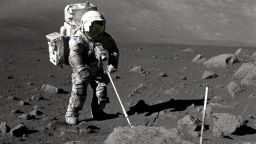Sign up for CNN’s Wonder Theory science newsletter. Explore the universe with news on fascinating discoveries, scientific advancements and more.
The moon has some new stories to tell.
Scientists have published the first detailed analyses of the historic cache of lunar soil and rock that China retrieved from the far side of the moon this year.
Chang’e-6, the first mission to bring back soil from the moon’s far side, collected 1.9 kilograms (4.2 pounds) of lunar soil via a robotic probe in June before returning to Earth, a scientific tour de force that cemented China’s place as one of the world’s top space powers.
Volcanic rock contained in the sample dates back 2.8 billion years, suggesting the uncrewed mission’s landing site was volcanically active at that time, according to two papers published Friday in the journals Science and Nature. The eruption represented a relatively recent episode of lunar volcanic activity not known from the study of samples taken from the moon’s near side by NASA’s Apollo program and Russia’s Luna missions, the new research found.

The age of the basalt rock from the far side is surprisingly young compared with the previously studied lunar near-side samples, which were all more than 3 billion years old, said Clive Neal, a professor at the University of Notre Dame and a coauthor on the Science paper. However, more recent near-side samples collected by China’s Chang’e-5 lunar mission in 2020 were found to be 2 billion years old.
The research also showed that the samples didn’t carry the signature of radioactive elements found in many Apollo-era samples.
“The relatively young age of the basalts (retrieved by Chang’e-6) is surprising along with the composition being practically devoid of radioactive elements,” Neal said via email. This “prompts the question ‘how and why were these magmas generated.’”
“This was the same question that is still being asked about the Chang’e 5 basalts,” he added.
‘Unresolved mystery’
The first soil samples from the moon, collected during the Apollo missions of the 1960s and ‘70s, effectively rewrote science textbooks, revealing how the moon formed and that it was once covered in an ocean of magma.
“One of the concerns, you know, we developed this detailed story (about the moon) from all the Apollo results,” said Richard W. Carlson, staff scientist emeritus at the Carnegie Institution for Science’s Earth & Planets Laboratory in Washington, DC. He was not involved in the new research.
“And one thing that has always kind of lingered in the back of my mind is whether that only applies to the Apollo area of the moon,” Carlson added.

NASA’s Apollo missions landed at six sites relatively near the moon’s equator between 1969 and 1972, while the Chang’e-5 spacecraft landed in the moon’s northwest corner. The Chang’e-6 lunar probe landed at a location within the sprawling South Pole-Aitken basin, an impact crater formed some 4 billion years ago.
Now, the Chang’e-6 samples can help scientists explore the differences between the moon’s near and far side, which had been previously detected by remote sensing, by unraveling the far side’s volcanic history, said Qiu-li Li, corresponding author of the Nature paper and a research professor at the State Key Laboratory of Lithospheric Evolution at the Chinese Academy of Sciences’ Institute of Geology and Geophysics.
The lunar near side always faces Earth — and therefore has been easier to study — because the moon takes the same amount of time to complete an orbit of Earth and rotate around its axis: about 27 days.
Earlier research based on remote sensing revealed that the moon’s far side has different topography, a thicker crust, a different distribution of basalt as well as different concentrations of thorium, a radioactive element found in rock, Li said.
“The asymmetry between the Moon’s nearside and farside remains an unresolved mystery,” he said in an email.
Li and his team studied 108 basalt fragments contained in two small samples of the lunar far side soil. Most of the fragments formed around 2.8 billion years ago, the researchers found by studying the decay of lead isotopes in the samples. However, one fragment formed around 4.2 billion years ago, according to the research.
The basalt fragments studied in the Science paper were also 2.8 billion years old. Together, the findings from the two studies suggest that the moon was molten for a longer period than initially thought, Carlson said.
“We don’t really have a good idea of why the Moon is molten that long,” Carlson said in an email. “The moon’s a pretty small body, and it should have cooled off pretty quickly.”
Both papers noted that the samples were not rich in KREEP, an acronym that stands for potassium (chemical symbol K), rare-earth elements (REE) and phosphorus (P) that has been found in other Apollo-era lunar samples.
KREEP is heat generating, Carlson said, and its existence would explain why volcanism continued on the moon for so long. He said it is interesting that the Chang’e-6 samples were devoid of the radioactive elements.
Future Chang’e-6 sample research

These initial analyses of the lunar soil samples raise questions that will take more time and the study of additional samples to address, Neal said.
The China National Space Administration has said that scientists from outside China could apply to study the soil samples two years after the specimens’ arrival on Earth, following a precedent NASA set decades ago with the Apollo missions.
The Apollo lunar flights ended in 1972, but NASA said it receives about 60 research requests for samples each year. More than 2,500 scientific papers had been published through 2015 using Apollo data, according to the space agency.
Li said that foreign researchers such as Neal are already able to collaborate with their Chinese counterparts as part of a team.
Neal said he was “pleasantly surprised” to be asked to be part of the project. However, he explained that he could only work on the research “after hours” to avoid violating the Wolf Amendment, a 2011 US law that prohibits the use of government funds by NASA for bilateral cooperation with China or its agencies without authorization from Congress or the FBI.
NASA Administrator Bill Nelson suggested in July that research of the Chang’e-6 samples might not violate the Wolf Amendment.
The space agency declined to comment on the studies but said it is coordinating with US researchers who applied for access to Chang’e-5 lunar samples.
“The agency is aware that as part of the application process CNSA interviewed the international loan applicants but has not announced selections,” NASA said.
The two papers published Friday were not the first research on the Chang’e-6 samples, Li said. A September paper characterized the samples but did not date them.









